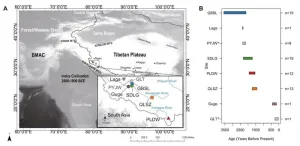(Press-News.org) EMBARGOED UNTIL 12:01 a.m. EST Wednesday, May 22, 2024
Contact:
Jillian McKoy, jpmckoy@bu.edu
Michael Saunders, msaunder@bu.edu
##
During extreme rain or rapid snowmelt, the high volume of water that enters sewer systems can cause untreated sewage to flow into waterways in US cities that have combined wastewater and stormwater sewer systems, including the Merrimack River in Massachusetts.
A new study led by Boston University School of Public Health (BUSPH) researchers has found that residents living in the downstream communities that border the Merrimack River are at a substantially increased risk of developing acute gastrointestinal illnesses (AGI) in the four days following large-volume combined sewer overflows (CSOs).
Published in the journal Environmental Health Perspectives, the study found that risk of AGI was elevated among all of the Massachusetts cities observed in the analysis, regardless of whether communities sourced their drinking water from the Merrimack River, suggesting that residents may be exposed to sewage-associated waterborne contaminants through pathways beyond drinking water.
Health experts worry that more extreme rainfall events due to climate change will spur additional large-scale CSOs, putting residents’ health at risk even further.
“The largest sewage releases occur when precipitation is most intense, as this produces a large volume of rainfall over a short amount of time,” says study lead and corresponding author Dr. Beth Haley, postdoctoral researcher and a doctoral student at BUSPH at the time of the study. “Our findings are concerning because climate change predictions suggest that heavy rainfall events will become more frequent and intense in the Northeast, which means that residents of communities exposed to sewage-contaminated waterways may experience increased risk of severe gastrointestinal illnesses.”
The study lends critical insight into the health implications of CSO events, as there is very little research on the health outcomes of populations who are exposed to the waterways affected by CSOs. The analysis is also the first study to investigate the role of drinking water sources in these possible connections between CSOs and AGI.
For the study, Dr. Haley and colleagues from Boston University, the University of Chicago, and New Leaf Energy utilized federal and state data to examine the volume and intensity of CSOs, along with hospital records of emergency department visits for AGI, based on diagnoses of infectious intestinal diseases, noninfectious gastroenteritis, vomiting, and diarrhea. The analysis included communities in all of the 17 northern Massachusetts cities that border the Merrimack River.
After adjusting for precipitation, the results showed that residents living in CSO-impacted communities were 62 percent more likely to develop AGI within four days after the largest sewage overflow events in the study period occurred compared to days with no CSO events. But there was no meaningful difference in AGI risk based on whether residents relied on drinking water from the Merrimack River, or other sources.
Exposure to sewage-associated pathogens in drinking water is particularly concerning because of the large number of people who do rely on public drinking water, the researchers say—so the lack of evidence connecting CSO-impacted drinking water sources to AGI risk in the study was a relief. But they are careful to note that the results do not necessarily indicate that drinking water sourced from CSO-impacted waterways is harmless.
“We cannot conclude that drinking water is not an exposure pathway following CSO events, but this study does suggest that other pathways—for example, exposure during water recreation—likely contribute more to the observed association,” Dr. Haley says.
More research is needed to better understand the role of drinking water on CSO-associated AGI risk, especially for populations who are more susceptible to microbial pathogens, such as immunocompromised people, older people, and young children, the team says.
Although cities such as San Francisco, Seattle, and Portland, Ore. have combined sewer systems, this type of infrastructure is more prevalent in the Northeast and Midwest, where systems were built during the mid-1800s to early 1900s in the country’s oldest cities.
“At that time, there was little concern that combining sanitary and storm sewers would be so problematic,” says study senior author Dr. Wendy Heiger-Bernays, clinical professor of environmental health at BUSPH. One of the main reasons CSO events still occur today, she says, is that combined sewer systems are expensive to separate, as are measures to minimize CSO occurrences. “Many cities that have combined sewer systems do not have the resources to make these large infrastructure investments without state or federal assistance.”
There is some movement to address these issues at the federal level now, Heiger-Bernays says. The Environmental Protection Agency (EPA) is working to implement long-term control plans and water quality improvement—and to make CSO data more readily available to the public—in accordance with the Clean Water Act.
“Massachusetts has done this at the state level following the passage of a 2021 law requiring notification of sewage overflow events, but a national system for notifications and data access does not currently exist,” she says.
**
About Boston University School of Public Health
Founded in 1976, Boston University School of Public Health is one of the top ten ranked schools of public health in the world. It offers master's- and doctoral-level education in public health. The faculty in six departments conduct policy-changing public health research around the world, with the mission of improving the health of populations—especially the disadvantaged, underserved, and vulnerable—locally and globally.
END
Sewage overflows linked to increase in gastrointestinal illnesses
A new BU study suggests the risk of people developing acute gastrointestinal illness is significantly higher in Massachusetts communities that border the Merrimack River in the four days following extreme combined sewer overflows
2024-05-22
ELSE PRESS RELEASES FROM THIS DATE:
Promethium bound: Rare earth element’s secrets exposed
2024-05-22
Scientists have uncovered the properties of a rare earth element that was first discovered 80 years ago at the very same laboratory, opening a new pathway for the exploration of elements critical in modern technology, from medicine to space travel.
Promethium was discovered in 1945 at Clinton Laboratories, now the Department of Energy’s Oak Ridge National Laboratory, and continues to be produced at ORNL in minute quantities. Some of its properties have remained elusive despite the rare earth element’s ...
New AI accurately predicts fly behavior
2024-05-22
We’ve been told, “The eyes are the window to the soul.” Well, windows work two ways. Our eyes are also our windows to the world. What we see and how we see it help determine how we move through the world. In other words, our vision helps guide our actions, including social behaviors. Now, a young Cold Spring Harbor Laboratory (CSHL) scientist has uncovered a major clue into how this works. He did it by building a special AI model of the common fruit fly brain.
CSHL Assistant Professor Benjamin Cowley and his team honed their AI model through a technique they developed called “knockout training.” ...
Study: Under extreme impacts, metals get stronger when heated
2024-05-22
Metals get softer when they are heated, which is how blacksmiths can form iron into complex shapes by heating it red hot. And anyone who compares a copper wire with a steel coat hanger will quickly discern that copper is much more pliable than steel.
But scientists at MIT have discovered that when metal is struck by an object moving at a super high velocity, the opposite happens: The hotter the metal, the stronger it is. Under those conditions, which put extreme stress on the metal, copper can actually be just ...
Firearm Homicide Demographics Before and After the COVID-19 Pandemic
2024-05-22
About The Study: In this study, death by firearm homicide was concentrated among Black individuals ages 15 to 24 before, during, and subsequent to the COVID-19 pandemic, implying that there are likely to be social and structural conditions that contribute to these racial disparities.
Corresponding Author: To contact the corresponding author, Alex R. Piquero, Ph.D., email axp1954@miami.edu.
To access the embargoed study: Visit our For The Media website at this link https://media.jamanetwork.com/
(doi:10.1001/jamanetworkopen.2024.12946)
Editor’s ...
Transmission of mental disorders in adolescent peer networks
2024-05-22
About The Study: The findings of this study suggest that mental disorders might be transmitted within adolescent peer networks. More research is required to elucidate the mechanisms underlying the possible transmission of mental disorders.
Corresponding Author: To contact the corresponding author, Jussi Alho, Ph.D., email jussi.alho@helsinki.fi.
To access the embargoed study: Visit our For The Media website at this link https://media.jamanetwork.com/
(10.1001/jamapsychiatry.2024.1126)
Editor’s Note: Please see the article ...
Transitioning gender identities is not linked with depression
2024-05-22
A landmark longitudinal study of LGBTQ+ youths has found that transitioning gender identities is not associated with depression and that about 1 in 3 gender-minority youths change their gender identity more than once. In fact, the study found higher rates of depression among transgender youths are more closely associated with bullying and victimization.
The findings from a team of researchers at The University of Texas at Austin and in Brazil are outlined in a paper in JAMA Network Open.
The study followed 366 LGBTQ+ young people ages 15-21 in two U.S. cities from 2011 to 2015 and measured depressive symptoms ...
Century-old vaccine protects type 1 diabetics from infectious diseases
2024-05-22
BOSTON--In new research, investigators at Massachusetts General Hospital (MGH) show that the 100-year-old Bacillus Calmette-Guérin (BCG) vaccine, originally developed to prevent tuberculosis, protects individuals with type 1 diabetes from severe COVID-19 disease and other infectious diseases.
Two back-to-back randomized double-blinded placebo-controlled trials found that the BCG vaccine provided continuous protection for nearly the entire COVID-19 pandemic in the US, regardless of the viral variant.
“Individuals with type 1 diabetes are highly susceptible to infectious diseases and had worse outcomes when they were infected with the SARS-CoV-2 virus,” ...
How and why different cell division strategies evolve
2024-05-22
Cell division is fundamental to life, enabling growth, reproduction, and survival across all organisms, from single-celled bacteria to complex multicellular animals. While animals and fungi share a common eukaryotic ancestry, their mechanisms of cell division, particularly mitosis, have diverged significantly, raising intriguing evolutionary questions.
Animals typically undergo open mitosis, where the nuclear envelope disassembles during cell division, while fungi exhibit closed mitosis, maintaining an intact nuclear envelope. The evolutionary reasons behind these divergent strategies ...
IPK research team uncovers mechanism for spikelet development in barley
2024-05-22
The inflorescence architecture of crop plants like barley is predominantly regulated by meristem activity and fate, which play a critical role in determining the number of floral structures for grain production. Spikelets are the basic reproductive unit of grass inflorescences. The identity and determinacy of many grass meristems are partially determined by a group of genes expressed specifically at organ boundaries, which can form local signalling centres that regulate adjacent meristem fate and activity.
These genes are critical for establishing and ...
Ancient DNA study reveals population history of Western Tibetan Plateau
2024-05-22
According to a study published in Current Biology on May 22, the genetic components of the ancient populations in the western Tibetan Plateau are closest to ancient populations in the southern Tibetan Plateau, and their major genetic components have been maintained over the past 3,500 years. In addition, these ancient populations in the western Tibetan Plateau had complex and frequent interactions with ancient populations inside and outside the plateau.
The study was conducted by Prof. FU Qiaomei's team from the Institute of Vertebrate Paleontology and Paleoanthropology ...
LAST 30 PRESS RELEASES:
Keck Medicine of USC names Christian Pass chief financial officer
Inflatable fabric robotic arm picks apples
MD Anderson and SOPHiA GENETICS announce strategic collaboration to accelerate AI-driven precision oncology
Oil residues can travel over 5,000 miles on ocean debris, study finds
Korea University researchers discover that cholesterol-lowering drug can overcome chemotherapy resistance in triple-negative breast cancer
Ushikuvirus: A newly discovered giant virus may offer clues to the origin of life
Boosting the cell’s own cleanup
Movement matters: Light activity led to better survival in diabetes, heart, kidney disease
Method developed to identify best treatment combinations for glioblastoma based on unique cellular targets
Self-guided behavioral app helps children with epilepsy sleep earlier
Higher consumption of food preservatives is associated with an increased risk of type 2 diabetes
NTU Singapore-led team captures first-ever ‘twitch’ of the eye’s night-vision cells as they detect light, paving the way for earlier detection of blindness-causing diseases
Global aviation emissions could be halved through maximising efficiency gains, new study shows
Fewer layovers, better-connected airports, more firm growth
Exposure to natural light improves metabolic health
As we age, immune cells protect the spinal cord
New expert guidance urges caution before surgery for patients with treatment-resistant constipation
Solar hydrogen can now be produced efficiently without the scarce metal platinum
Sleeping in on weekends may help boost teens’ mental health
Study: Teens use cellphones for an hour a day at school
After more than two years of war, Palestinian children are hungry, denied education and “like the living dead”
The untold story of life with Prader-Willi syndrome - according to the siblings who live it
How the parasite that ‘gave up sex’ found more hosts – and why its victory won’t last
When is it time to jump? The boiling frog problem of AI use in physics education
Twitter data reveals partisan divide in understanding why pollen season's getting worse
AI is quick but risky for updating old software
Revolutionizing biosecurity: new multi-omics framework to transform invasive species management
From ancient herb to modern medicine: new review unveils the multi-targeted healing potential of Borago officinalis
Building a global scientific community: Biological Diversity Journal announces dual recruitment of Editorial Board and Youth Editorial Board members
Microbes that break down antibiotics help protect ecosystems under drug pollution
[Press-News.org] Sewage overflows linked to increase in gastrointestinal illnessesA new BU study suggests the risk of people developing acute gastrointestinal illness is significantly higher in Massachusetts communities that border the Merrimack River in the four days following extreme combined sewer overflows



